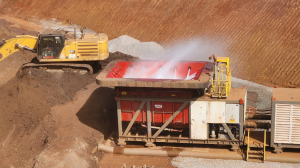In response to rising demand for sustainable mining practices, equipment, services and solutions supplier IHC Mining has launched a suite of advanced tailings rehandling and reprocessing solutions to help mining companies reduce their ecological footprint and extract additional value from mining waste.
With an emphasis on reducing water consumption, carbon emissions and operational costs, IHC Mining’s approach supports the industry’s shift toward a circular economy, says senior mining consultant Matthijs Bootsma.
He explains that tailings pose both challenges and opportunities for mining companies, noting that, traditionally, handling tailings required costly, labour-intensive processes like trucking material and hydraulic mining processes, often with significant environmental impacts.
However, IHC Mining’s new solutions use integrated systems and equipment to simplify tailings management, conserve resources and provide a more sustainable alternative to conventional methods.
Bootsma explains that IHC Mining’s approach emphasises an end-to-end, integrated model designed to address both legacy and active tailings storage facilities (TSFs).
According to Bootsma, the company’s process starts in an in-house laboratory where tailings samples are tested to create an optimised reprocessing plan.
From there, IHC Mining provides customised equipment and technologies tailored to each site’s unique conditions.
“This approach minimises risks and reduces capital expenditures by aligning each phase of rehandling to the client’s operational needs,” he tells Mining Weekly.
Specifically, the company offers specialised solutions for both submerged and semi-dry TSF environments. For submerged tailings, IHC Mining’s electrically-powered cutter suction dredgers, such as those deployed at diversified miner Vale’s Gelado project in Brazil, allow for efficient, emission-free dredging.
In semi-dry TSFs, the tailings slurrification unit (TSU) and the dry mining slurrification unit provide cleaner, cost-effective alternatives to traditional truck-and-shovel or hydraulic mining techniques.
Through recognising the economic potential within tailings, IHC Mining helps clients transform waste into valuable resources, says Bootsma, adding that while tailings often contain lower grade minerals than primary ore, cost-effective recovery methods can make reprocessing thereof profitable.
“With our background in dredging and pump technology, we focus on minimising operational costs so clients can turn these low-grade materials into a viable resource,” he comments, noting that electrically-powered equipment and closed-loop slurry pipe- lines further help IHC Mining reduce environmental impact, conserve water and lower emissions.
However, cost remains a central consideration in tailings rehandling projects, and IHC Mining’s slurry transport solutions offer a more efficient alternative to truck-based methods.
With the TSU, mining companies can bypass the need for haul trucks, significantly lowering operating expenses associated with fuel, labour and maintenance.
“By using pipelines to transport slurrified tailings, we’re able to minimise the need for equipment and reduce the number of personnel required on-site,” explains Bootsma, adding that this also reduces the overall carbon footprint.
Traditional hydraulic mining, which uses large amounts of water and requires fixed infrastructure, is often impractical in water-scarce regions. In contrast, he says the TSU uses a closed system that conserves water by preventing losses from evaporation and infiltration, making it particularly useful in arid mining areas such as Chile and Peru, where water must sometimes be sourced from costly desalination plants.
In submerged environments, IHC Mining’s dredging technology provides an efficient solution for tailings re-mining. By dredging tailings that are already saturated, IHC Mining reduces the energy needed for material movement, allowing fine-grained particles to be pumped over long distances with low wear on equipment.
Bootsma explains that the lower maintenance costs associated with dredging pipelines enhance the method’s cost-effectiveness while keeping operations environment friendly.
He notes that by viewing legacy tailings as potential sources for minerals, mining companies can extract valuable materials without having to pursue greenfield sites, which aligns with both economic and environmental objectives.
The additional revenue from reprocessed tailings can also offset the costs of relocating TSFs for environmental and safety reasons, presenting an attractive option for mining companies looking to enhance sustainability, says Bootsma.
In addition to direct economic benefits, IHC Mining’s tailings solutions further enable clients to optimise resource estimation and recovery rates through specialised testing and flow sheet design.
In-house metallurgical testing helps identify the most effective separation circuits, enabling clients to increase the recovery of valuable minerals, while conserving water and energy resources.
“By leveraging electrically-powered equipment and efficient slurry pipelines, IHC Mining’s solutions support mining companies in reducing their carbon footprint and conserving water, addressing some of the industry’s most pressing environmental concerns,” concludes Bootsma.
Edited by: Donna Slater
Features Deputy Editor and Chief Photographer
EMAIL THIS ARTICLE SAVE THIS ARTICLE
ARTICLE ENQUIRY
To subscribe email subscriptions@creamermedia.co.za or click here
To advertise email advertising@creamermedia.co.za or click here















